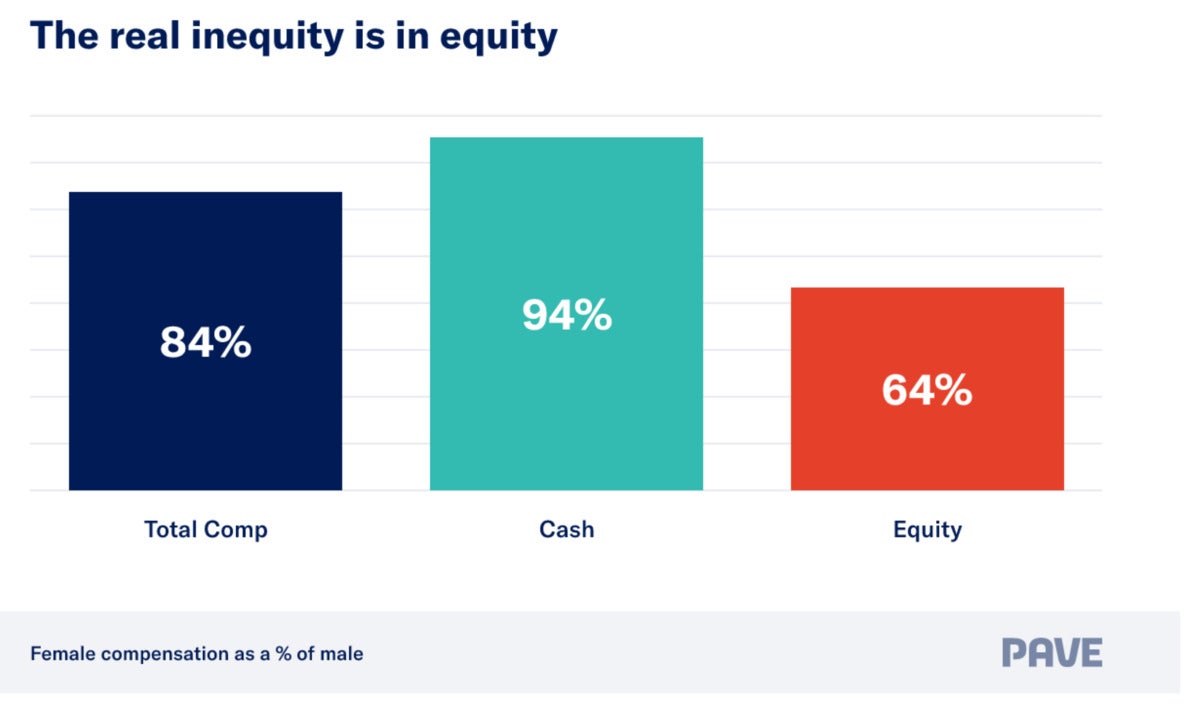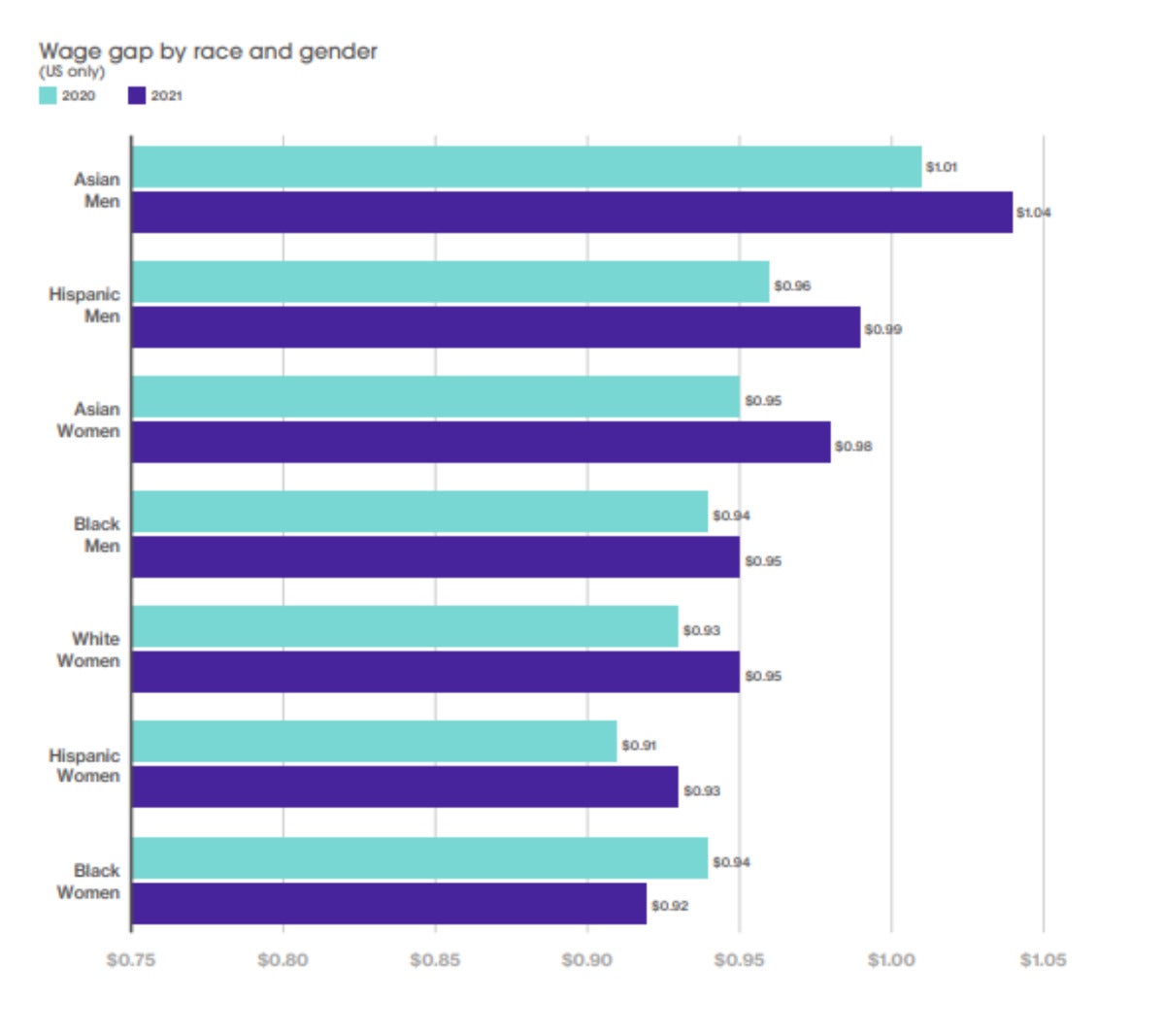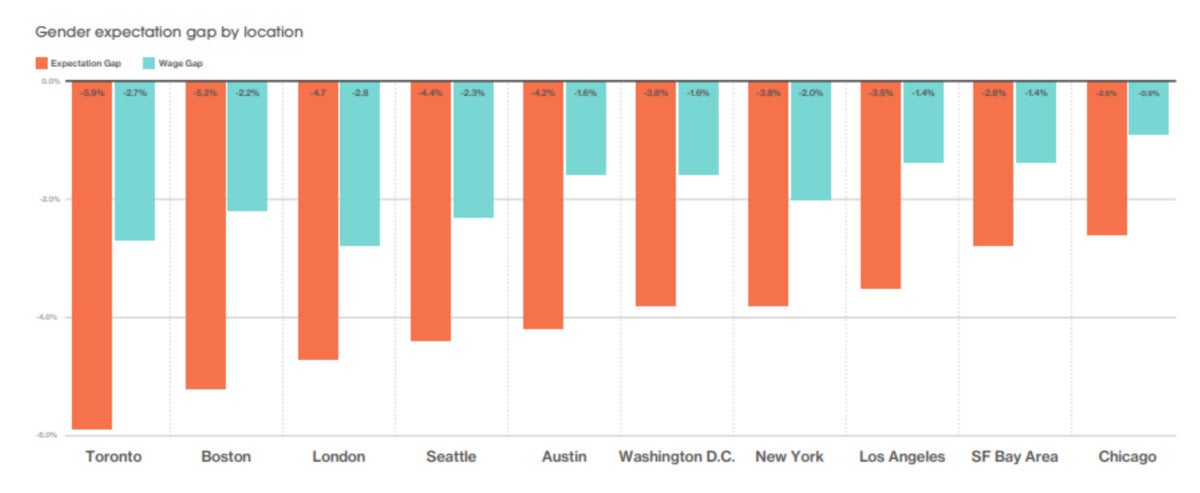































The gap between what white men are paid and how much women and minorities earn has narrowed over the past few decades.
The latest data from the US Census Bureau shows women now make about 82 cents on the dollar compared with their male counterparts. (Other studies show women make about 98 cents on the dollar compared with men.)
But the most recent studies show a much wider gap when it comes to overall compensation, which includes salary, bonuses, equity sharing, healthcare, titles, and any other benefits given to employees. For example, Restricted Stock Units (RSUs) are often issued to an employee through a vesting plan and distribution schedule after achieving required performance milestones.
Stock options and equity grants are far more skewed, especially for women in technology jobs. Female software engineers, for example, only make 64 cents on the dollar compared to men, according to Pave, a company that sells employee pay benchmarking tools.
"That's the one that's extremely alarming in my opinion," said Pave CEO Matt Schulman.
 Pave
Pave Start-up companies, in particular, tend to offer less compensation to women through equity sharing plans than to their male counterparts, according to other industry studies.
By comparison, when it comes to only cash compensation, Pave's study showed women make 94 cents to the dollar compared to men. Pave's data comes from its HR software, which is used by 2,600 customers' systems.
Gaps in salary also tend to become normalized over time as employees gain seniority, but compensation - such as corporate profit sharing or stock options - tends to remain stagnant over an employee's career. "The value of equity may be$100,000 today, but what about when the company is worth$1 billion or$10 billion. Deltas in equity compensation get bigger over time where cash is a one-way door," Schulman said.
Research association Conference Board performed an analysis of US employment data and found only 4% of top earners in the tech industry are Black, compared to 6% in other industries. And "among software developers - who have seen the highest income growth of all - Black representation stands at just 3.3%, the report said.
And Conference Board's report showed the disparity is growing for Black men in tech. In 2010, they earned 18% less than white men - a disparity that grew to 24% by 2019, "largely due to increased underrepresentation of Black workers in high-paying industries and occupations" such as tech, the Conference Board report said.
While states have been addressing pay inequity through fair compensation laws, those statues mainly effect cash compensation. More opaque is equity compensation, which is a missing aspect of the fair pay laws, Schulman said.
"An employee's ability to assess fairness in compensation depends on the transparency of their offer," Shulman said. "Given the obscured value and natural complexity of equity, bias is amplified in cases of equity offers. We need to incentivize companies to be transparent about everything - explaining how equity sharing works to employees."
Online job search site Hired recently released its annual State of Wage Inequality in the Tech Industry report. The study also showed that while the wage gap across gender and race is narrowing, it's still prevalent. Black women continue to see the widest gap among the demographics analyzed.
"In 2021, the wage gap narrowed by race and gender across all races, except for Black women," Hired said.
 Hired
Hired Black women saw a decrease from 94 cents to 92 cents for every$1 a white male counterpart earns. Asian men, Hispanic men and Asian women had the narrowest wage gaps in 2021, respectively ($1.04, 99 cents and 98 cents, respectively, for every$1 a white male counterpart earns), Hired reported.
Hired's Impact Report also uses "wage expectations" as a measure of inequity among underrepresented candidates (i.e., women and minorities). Hired's data this year continued to show groups who are paid less also expect lower salaries than their white male counterparts -even if they have the same experience.
Race and gender combined are the strongest drivers to the "expectation gap," with Hispanic women and Black women only expecting 91 cents to every$1 salary of their white male counterparts.
Hispanic and Asian candidates reported a 1.5% and 1% percentage expectation gap improvement, respectively, but Hispanic and Asian women showed a wider expectation gap than their male counterparts.
In addition, Black candidates showed a slight widening of 0.1% in the wage expectation gap -the only increase across candidates in 2021, according to Hired.
Payscale, a provider of cloud compensation management software, has been publishing a Gender Pay Gap report since 2015 that tracks total cash compensation for employees whose company uses their software.
In its most recent report, published in March, Payscale found significant disparities in compensation, or an employee's base pay, when uncontrolled pay gaps were measured. Promotional favoritism, negotiating tendencies, and outright bias are just a few factors involved.
 Hired
Hired While women have a growing presence in higher-paying industries such as information or professional, scientific, and technical services, they are still over-represented in lower paying industries. And as women age, the pay gap widens even more, according to the US Census Bureau's Quarterly Workforce Indicators. According to the most recent data from the US Census, women in the US earned 30% less than men and that pay gap increased with age.
Payscale's studies look at "controlled" versus "uncontrolled pay gaps;" controlled gaps amount to "equal pay for equal work" or when all compensable factors are accounted for, including job level and title, education, years of experience, industry, and hours worked. The uncontrolled pay gap, which only accounts for gender, is a better indicator of the types of jobs and the associated earnings occupied by women versus men, Payscale said.
While the controlled gender pay gap is narrower, with women being paid 99 cents for every$1 men make, closing the gap has been ponderously slow, according to Payscale's study.
"Even more concerning, is the pay disparity revealed in the uncontrolled pay gap.... In this instance, women earn only 82 cents for every$1 men make," Payscale said.
Payscale's study, however showed there has been progress in other areas, specifically new hires. In 2020, 42.4% of interview requests for open tech positions were sent only to male candidates, according to Hired. In 2021, that had dropped to 36.7%.
"This is progress, but means nearly 40% of roles are not requesting interviews with female candidates at all," according to Hired.
"It's been an ever-shifting and evolving hiring landscape for employers and jobseekers over the last few years -from companies competing and sourcing for talent at a record pace, to the current state of macroeconomic uncertainty driving more measured hiring," Hired CEO Josh Brenner said in a statement.
"This report shows that there is still work to be done in ensuring equitable hiring processes to narrow wage and expectation gaps, and companies must prioritize this effort," Brenner said. "Post-Great Resignation, companies that are successful in identifying non-traditional talent, while also ensuring diversity and representation in their candidate pipelines, will be better positioned to drive their businesses forward in a time of increased volatility."
 Hot Tags :
IT Jobs
Startups
Diversity and Inclusion
Salaries
Hot Tags :
IT Jobs
Startups
Diversity and Inclusion
Salaries